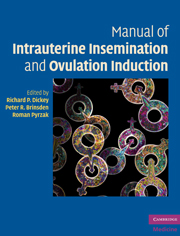Book contents
- Frontmatter
- Contents
- List of contributors
- Preface
- 1 An overview of intrauterine insemination and ovulation induction
- 2 Male causes of infertility: evaluation and treatment
- 3 Female causes of infertility: evaluation and treatment
- 4 Clinic and laboratory design, personnel and equipment
- 5 Semen analysis: semen requirements for intrauterine insemination
- 6 Semen preparation for intrauterine insemination
- 7 Ovulation induction for intrauterine insemination I: oral drugs clomiphene, tamoxifen, letrozole
- 8 Ovulation induction for intrauterine insemination II: gonadotropins and oral drug–gonadotropin combinations
- 9 Ultrasonography in the management of ovulation induction and intrauterine insemination
- 10 Insemination technique and insemination complications
- 11 Cryopreservation
- 12 Donor sperm
- 13 The role of the nurse in intrauterine insemination and ovulation induction
- 14 Complications of ovulation induction I: high-order multiple births, miscarriage, ectopic pregnancy, congenital anomalies, ovarian cancer
- 15 Complications of ovulation induction II: ovarian hyperstimulation syndrome, ovarian torsion
- 16 The psychological issues of intrauterine insemination
- 17 Ethical, legal and religious considerations of artificial insemination
- Index
12 - Donor sperm
Published online by Cambridge University Press: 01 February 2010
- Frontmatter
- Contents
- List of contributors
- Preface
- 1 An overview of intrauterine insemination and ovulation induction
- 2 Male causes of infertility: evaluation and treatment
- 3 Female causes of infertility: evaluation and treatment
- 4 Clinic and laboratory design, personnel and equipment
- 5 Semen analysis: semen requirements for intrauterine insemination
- 6 Semen preparation for intrauterine insemination
- 7 Ovulation induction for intrauterine insemination I: oral drugs clomiphene, tamoxifen, letrozole
- 8 Ovulation induction for intrauterine insemination II: gonadotropins and oral drug–gonadotropin combinations
- 9 Ultrasonography in the management of ovulation induction and intrauterine insemination
- 10 Insemination technique and insemination complications
- 11 Cryopreservation
- 12 Donor sperm
- 13 The role of the nurse in intrauterine insemination and ovulation induction
- 14 Complications of ovulation induction I: high-order multiple births, miscarriage, ectopic pregnancy, congenital anomalies, ovarian cancer
- 15 Complications of ovulation induction II: ovarian hyperstimulation syndrome, ovarian torsion
- 16 The psychological issues of intrauterine insemination
- 17 Ethical, legal and religious considerations of artificial insemination
- Index
Summary
Introduction
Donor insemination is the only insemination procedure performed by many physicians. It is convenient, easy to perform and requires no special equipment. Unwashed donor sperm can be purchased from commercial sperm banks “ready to use.” Commercial sperm banks usually provide specimens in screw-topped polypropylene cryovials containing 10–30 × 106 motile sperm after thaw in 1 mL media. Specimens may be either prewashed for intrauterine insemination (IUI) or unwashed for vaginal (IVI) or intracervical insemination (ICI). Unwashed specimens can also be used for IUI after they are washed by the recipient clinic. Specimens may also be provided in straws in 0.5 mL of media.
Unwashed specimens need only to be thawed at room temperature or in warm water for 5–10 minutes to be ready for IVI and ICI. IUI specimens require centrifugation to remove the cryoprotectant, even if they were prewashed. Because liquid nitrogen (LN2) is extremely hazardous if spilled, specimens are usually “dry” shipped in smaller versions of the Dewar LN2 tanks used for long-term storage (Fig. 12.1). Dry-shipping tanks contain small amounts of LN2 at the bottom sufficient to maintain the temperature of vials or straws suspended in LN2 vapor at −180°C for 10–12 days from the date the shipper was filled. Sperm specimens that can not be used within this time may be transferred to regular larger LN2 tanks for long-term storage. A few commercial banks still ship donor sperm in dry ice overnight for use the next day.
- Type
- Chapter
- Information
- Manual of Intrauterine Insemination and Ovulation Induction , pp. 130 - 137Publisher: Cambridge University PressPrint publication year: 2009



